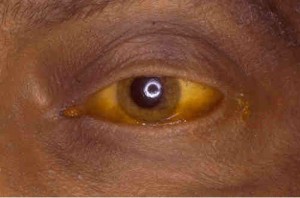If you have started showing early liver disease symptoms, it is recommended that you seek the expert opinion of a medical practitioner to confirm the same and seek medical recourse. The symptoms of liver problems are not too subtle, and you’ll be able to identify them over the course of a few weeks.
Liver symptoms can range from mild and intermittent headaches and nausea to polyuria (frequent urination). Listed below are some of the most prominent liver disease symptoms.

Liver Disease Symptoms
Jaundice
Jaundice is the most prominent symptom of liver disease as it’s the basic indication if there is anything wrong with either the liver or the gall bladder. Jaundice can be commonly observed, as the skin generally sports a yellowish orange color. The sclera (white part in the eye) displays a shade of yellow too.
The cause behind jaundice is the improper or insufficient production of bile in the liver. Bile helps in processing old blood and when bile is not properly produced, the problem results in jaundice. Sometimes, jaundice can be accompanied by other symptoms such as flu or joint aches.
This can be a result of an infection in the gall bladder or a contraction of acute hepatitis. It is better to visit a hospital or a medical facility to get the symptoms thoroughly checked in this case. As per traditional oriental medicine, two types of jaundice exist:
-
Yang Jaundice
Constipation, palpitation, thirst, urinary problems, yellowing of the tongue as well as abdominal distention are a part of the symptoms that are highlighted in this form of whole body jaundice. The body color changes to tangerine and this is generally brought on by moist heat and excessive dampness.
-
Yin Jaundice
Severe fever, poor appetite, nausea, fatigue, lassitude, loose stools, hypochondriac pain, palpitation, cold feet and hands, breaking breath, and edema are the most common symptoms of Yin Jaundice. The face, eyes and skin turn yellowish in this type of jaundice.
Appetite and Digestion
Another very common symptom that goes hand in hand with liver disease is loss or change in appetite. This is why liver disease causes weight loss in some cases. The weight loss can further trigger incorrect metabolism of the fats, proteins and carbohydrates present in the body, worsening the condition of the pre-existing liver problem.
This loss of appetite soon kick starts a chain of events which begins with anemia as the hepatocytes, cells in the main tissue in the liver, keep degrading.
At the onset of diarrhea, vomiting and nausea, the body becomes weaker and the presence of even a single gastric ulcer in the body can cause bouts of blood vomit. The gastric ulcers grow faster due to the reactions between the nitrogen, bile acids, gastrin, mucus membrane and the histamine that line the walls of the stomach.
Coloration of the Stool
The stool also shows initial signs of discoloration as it becomes lighter in color and pale. This is brought on if there is a problem with the secretion of the bile pigments, which is caused either due to a blockage in the bile ducts or because of a stop or drop in the level of bile secretion.

Almost all liver and gall bladder diseases cause irritable as well as irregular bowel movements. The bile gives the stool its natural dark color, but due to the blockage in the bile duct or the improper secretion of bile, the stool takes up a lighter color, which is an indicator that something is wrong with either the duct or the liver itself. The ducts are generally blocked because of stones, inflammation or scarring.
Distention and Bloating
Another symptom is distention of the abdomen. This occurs near the lower part of the right side of the rib cage, and this is caused because of ascites or hepatomegaly. As the distention takes a turn for the worse, there is an applied pressure on the diaphragm which results in pain during breathing.
Polyuria and Polydyspia
Polyuria means excessive and very frequent urination and polydyspia means excessive abnormal thirst. These are common symptoms among many diseases, but they are also noticeable in people suffering from liver diseases.
When doctors pen down reasons for liver transplant, these are the other minor liver disease symptoms they look for:
-
Skin problems
-
Allergies
-
Headaches
-
Nausea
-
Seizures
-
Eye irritation
-
Itching skin
-
Mood swings
-
Back aches
-
Strokes
If any of these liver disease symptoms are manifested together and persist over a period of time, it is recommended that you consult your medical practitioner immediately. Liver failure generally requires a liver transplant surgery as treatment. This can be determined in a liver function test.
Research has shown that among a group of ten patients who died because of a lack of compatible livers for transplants, at least five of them were ignorant to the symptoms of transplant rejection that they were facing till it was too late. This is one of the main reasons why you’ll need to monitor your health regularly through medical checkups to ensure that your body doesn’t spring a surprise from the blue.